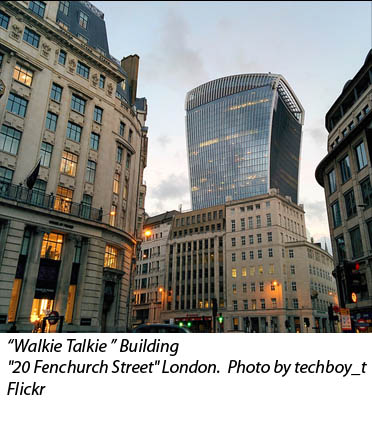Rowen Moore and I are activists on a mission to stop the spread of the term “iconic” in architecture. Moore, The Guardian’s architectural critic, opened his review of “Walkie Talkie” (20 Frenchchurch Street, London) with this plea, “When, for the love of God, will the word iconic finally die?” I like Moore’s synonym for iconic –“whooshy.” He means the building is curvy instead of office tower vertical.
He warns that the word “iconic,” without an exact definition, is at least ambiguous. But, Moore’s concern is the worst case scenario. Does green space on the roof of a curvy (iconic) building lead to the misappropriation of public space?
That’s why when I read a tweet about “Walkie Talkie,” (20 Frenchchurch Street) yesterday, the words iconic and public caught my attention. When these two words are linked, its a red flag. “Iconic” often translates into public/private investment. The next question should be how much does private investment in a public building justify their right to control public space?
My focus on the word iconic started in 2010 when the city of St. Petersburg, Florida revealed the top three “iconic” designs (iconic was a stated requirement in the RFP) for The Pier, the city’s landmark.
All the new designs had one thing in common; they were curvy or what Moore calls “whooshy.”
I’m a fan of curves, still that similarity prompted me to innocently ask why are curves suddenly more fashionable in architecture? I was keenly interested in the story since the city was about to get an image makeover via an “iconic” new building. It was a stark contrast to the existing landmark, the Inverted Pyramid, which is proudly triangular (curves vs. angles, that’s a subject for another post). Yet, I intuitively knew that cities don’t tear down their signature attractions (Would Seattle tear down the Space Needle?). The answer to that question is no — not without a fight anyway. St. Petersburg picked a fight. In 2010, architect Michael Maltzan won the contract for the Lens, but after countless public hearings, and a city-dividing referendum, the contract was cancelled. Since then, my research has revealed that the debate over what is meant by “iconic” is repeated in many cities.
Moore’s point is that language matters. Here’s an example: he cites an advertisement put out by LandSecurities (London’s development partner) boasting that the Walkie Talkie offers the “UK’s tallest public park.” Wait! Before you call Auntie Hilda to rendezvous there for a cup of tea and a sky high view of the city from the rooftop garden, you must make a reservation 3 days in advance on a website. As Moore describes the “park,” it becomes apparent that it’s a fringe of greenery surrounding two chic rooftop restaurants. Ultimately, the problem with “whooshy” buildings, says Moore, is that developers and city planners get caught up in the “thrill of creating an icon.”
The issue is again timely to the St. Petersburg Pier. Seven new “iconic” Pier designs were released last week making international architectural news.
Yet, we still don’t know the difference between “iconic” and “whooshy”. Will the city get what it expects? Will it satisfy what most people want? Is this a new park? Will every place on the new Pier be forever open to all residents? It turns out that iconic is a word with tendrils as stealthy as a wisteria vine. Beware those wispy green shoots, for they soon become strong enough to wrap themselves around its host and strangle the life out of it.

